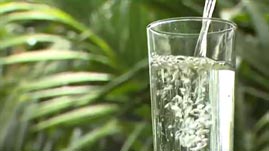Teachers' Domain - Digital Media for the Classroom and Professional Development
User: Preview

Source: GEF Pacific IWRM Project (SOPAC)
Explore some of the threats to the freshwater supply on Majuro Atoll in the Marshall Islands, in this video adapted from the Secretariat of the Pacific Community. All of Majuro’s fresh water comes from a surface catchment basin at the airport or from a natural underground formation called a freshwater lens on the western part of the atoll. Islanders explain how pumping too much water from the lens and how human waste can endanger the supply. They also describe how the local protection committee studies how certain human activities and chemicals affect the lens. Note: This video includes native languages and is subtitled in English.
Vocabulary:
On low-lying coral atolls, fresh water is a precious resource that must be carefully managed. These islands receive less rain than high volcanic islands, where mountains force winds upward, causing moisture in the air to form rain clouds. For most atoll communities, the main source of fresh water is rainfall that is stored in catchments.
When catchments run dry because of drought or overuse, islanders must use ground water. Ground water fills the spaces between soil particles and cracks in rocks below the surface. When rain falls, it seeps through these openings until it reaches the saturated zone—where the spaces and cracks are already filled with water. The areas that water seeps through to reach the saturated zone are called recharge zones. On atolls, much of the ground water is salty like the surrounding sea. Fresh water from rain floats on top of the salty water because salt water is denser than fresh water. The weight of the fresh water pushes down on the salt water beneath it, forming a freshwater lens.
Freshwater lenses are not very deep and do not contain a very large volume of water. When islanders need fresh water, they drain it from the lens through wells. This empties the lens a little at a time. The lens gets refilled when it rains.
There are several threats to an atoll’s freshwater supply. Digging wells and drawing ground water from them must be done with care. If the wells are dug too deep, or if too much water is drawn out at a location where the lens is not thick enough, salt water may mix with the fresh water, making the water unsuitable for drinking or irrigation. Seepage from septic tanks and cesspools, waste dumps, underground gas tanks, farms, and cemeteries can also pollute the freshwater lens.
In addition to these human-made threats are threats caused by climate change. Scientists predict that atolls will get less rainfall overall. This means that freshwater lenses and catchments will not be recharged as frequently. When rain does come, scientists predict it will be heavier than normal and cause flooding. This may cause pollutants to contaminate recharge zones.
Atoll communities are taking action to secure their freshwater resources—for example, by eliminating leaks along water supply lines and expanding household rainwater catchment systems. Some communities are exploring technologies such as desalination, a process that converts salt water to fresh water. Others are working with scientists to better predict the impact of climate change on the atolls.
Here are suggested ways to engage students with this video and with activities related to this topic.
Class activity: To model a freshwater lens, first, add several drops of food coloring to a glass or beaker of fresh water. Next, mix a solution of salt and water—at least one tablespoon—and pour it into a second glass or beaker. Add several drops of a different color of food coloring to the saltwater solution and stir. Slowly pour some fresh water on top of the salt water. The fresh water should float on top of the colored salt water, demonstrating that salt water is denser than fresh water.
Class activity: Either before or after watching the video, perform an experiment to determine which is heavier: salt water or fresh water. Gather the following materials, and then proceed with the experiment.
Materials:
Procedure:
1. Weigh one cup of fresh water. Have students note the weight. Then empty the measuring cup.
2. Fill the glass about 2/3 full with fresh water. Stir in about 10 to 15 spoonfuls of salt. Stir until the salt is dissolved.
3. Pour one cup of the salt water into the measuring cup and weigh it.
4. Compare the weights. Which is heavier: a cup of fresh water or a cup of salt water? Why do you think this is?
 Loading Standards
Loading Standards